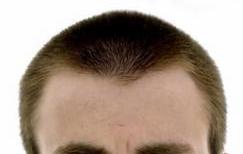Archive for May, 2009
Friday, May 22nd, 2009
 We are getting another question on the Propecia use in men whom their wives are pregnant. A hair loss patient just asked about possible side effects that finasteride (Propecia) may cause. He has read on the manufacturer’s instructions that broken tablets must not be handled by women who are or may become pregnant. We are getting another question on the Propecia use in men whom their wives are pregnant. A hair loss patient just asked about possible side effects that finasteride (Propecia) may cause. He has read on the manufacturer’s instructions that broken tablets must not be handled by women who are or may become pregnant.
“Can finasteride cause damage to pregnant womens health or to the health of the developing fetus? Here I’d like to know also if finasteride can be found in body liquids such as men’s saliva, sweat or sperm. In such case is there any risk that a pregnant woman is exposed to finasteride? Are there any recommendations concerning taking or not Propecia before planned or during wife’s pregnancy?”
The answer to this patient’s question, which is a common question that many of young patients may ask is that finasteride (Propecia) blocks the conversion of testosterone to dihydroxytestostrone (DHT). DHT does not have any known role in adult men development, but it is crucial in development of a male fetus and child external genitalia (their penis). We at our Los Angeles, California hair transplant clinics don’t recommend taking finasteride for hair loss prevention and treatment before adulthood while maturation of external genitalia is not completed. Pregnant women should not take finasteride because of its effect on the external genitalia of their male unborn baby.
As we all know, finasteride (Propecia) is designed to block the enzyme that converts testosterone to Dihydrotestosterone (DHT). DHT does not have any real known role in an adult male but it is crucial in the developmental stage of a male fetus as well as the development of a young male’s external genitalia (penis). After reviewing the facts at our Los Angeles, California hair transplant clinics we do not recommend taking finasteride for hair loss prevention and / or treatment before adulthood while maturation of external genitalia is not completed. For this same reason, pregnant women should not take or handle finasteride because of its effects on the male external genitalia of an unborn baby.
Although the pharmaceutical company suggested that pregnant women should not be exposed to finasteride. They should not even be cutting pills that might increase the chance of inhaling small particles of finasteride. You are right about finasteride being present in body secretion such as semen and saliva. However, the amount of the medication is so small that it is considered negligible or safe for pregnant women. So the research shows that it is safe for pregnant women to be exposed to the secretions of a man whom takes finasteride. That is why we do not recommend men to stop taking finasteride if their wife becomes pregnant. There has been no evidence of any risk to a male baby from secretion of finasteride through the father’s saliva, sweat or sperm.
They even mention cutting, ingestion or inhalation of small particles of finasteride to be harmful during pregnancy. You are right to be concerned of finasteride being present in body secretion such as semen and saliva. You can find a very small trace of finasteride in body secretions but the amount of the medication is so small that it is considered negligible or safe for pregnant women. Studies show that pregnant women can be exposed to male secretion even if they are currently taking finasteride. Studies have not found any evidence of risk to a male baby from secretion with trace of finasteride through the father’s saliva, sweat or sperm. So in short we conclude that men do not need to stop using finasteride while having their wives pregnant.
Tags: dht, dihydroxytestostrone, external genitalia, fetus, Finasteride and pregnancy, hair loss, male baby, men hair loss, penis, pregnancy, semen, sperm, sweat
Posted in hair loss medication, hair loss products, men hair restoration | No Comments »
Tuesday, May 19th, 2009
 “How can a male hairline be converted to a female pattern?” “How can a male hairline be converted to a female pattern?”
Although not always a very typical question or request, it is generally an issue most male to female transgender patients have to deal with. This is usually due to maturation of the hairline which may include recession of the frontal corners in mature male patterned hairline. This is what defines the frame of a male face as “masculine”. This can easily be restored through hair transplant surgery through follicular unit transplantation.
“I am already taking Propecia and Spironolactone to block my testosterone effect.”
Anti-testosterone medication can help minimize the effect of miniaturization or the balding of the hair connected with male patterned baldness but it does not stop the balding process completely. This is due to testosterone still being produced by the testicles. Post operative transgendered patients whom have had removal of their testicles as part of a transgender procedure can eliminate testosterone. This in turn can stop the process of male pattern hair loss in patients who are genetically prone to DHT (dihydrotestosterone).
Your hair transplant surgeon should have a good understanding of facial proportion and female hairline shaping in the process of transsexual hair transplantation. That is why transsexual hair transplantation should be treated meticulously and professionally. There are many different variants between a male and female hairline. This includes the location of the hairline from eyebrow level at mid frontal and laterals; temples need to be restored in a complete female shape; direction and orientation of hair shafts are also different between men and women. These little details and features must be meticulously cared for and that’s what can be expected through quality hair restoration for transgendered patients.
A hair transplant procedure is a good recommendation if you are looking into changing your hairline from a mature male hairline to a feminine one. This may also apply if you are suffering from male patterned baldness. We do recommend that you continue your regular medical treatment of anti-testosterone medication and a hair transplant to reshape the frame of your face. Maximum fullness and a perfect female pattern can generally be achieved through more than one procedure.
Tags: hair transplant surgeon, M-F Transgendered, trans gender, trans gender hair transplant surgeon, Trans women, transexual, transgender, transgender hair transplant, transse, transsexual, transsexual hair transplant
Posted in California hair transplant, hair loss medication, hair transplant, men hair restoration, Newport Beach hair transplant, Orange County hair transplant | No Comments »
Saturday, May 16th, 2009
 Above: Before and Below: After Latisse Latisse is the name of a new medication that is used for elongation of eyelashes. As a glaucoma medication, biatoprost has been available, used and prescribed to control the progression of glaucoma and to manage ocular hypertension. It is also designed to reduce intraocular pressure. Although biatoprost does what it is designed to do, one of the documented side effects of the glaucoma medication is lengthening of the eyelashes. As of December of 2008, the FDA has approved the use of this product for eyelash lengthening under the name of Latisse by Allergan.
This is a perfect example of an unusual and/or unexpected side effect that has been put to use for its key advantages. Another example is the drug minoxidil which was originally used as a blood pressure medication but as a result of its use, hair growth was reported as a side effect. Now minoxidil is another FDA approved drug used in Rogaine topical for hair loss prevention and treatment.
For people interested in having longer, fuller and natural eyelashes without surgery or makeup, Latisse is the best option available by prescription. Eyelash hair transplant surgery is another method that would use scalp hair to be implanted into the eyelash area as well. The best candidates for eyelash hair transplant surgery are people whom have little or no eyelashes on all or part of their eyelash area. If you have eyelashes and are looking into making them longer and fuller, Latisse might be your best option.
If you are interested in ordering Latisse, please contact us at 888-302-8747. We do have a special rates for Spring of 2009.
Tags: eyelash hair restoration, latisse
Posted in hair loss medication, hair loss products, women hair loss | No Comments »
Tuesday, May 12th, 2009
There is a great difference in hair design between a child and an adult. Most notably is that between a boy and a man. As men get older, the hairline takes on a different design. This is known as maturation of the hairline. Many young men in their early 20s come to our California Hair Transplant centers worried about recession of their hairline in the corners hoping they can get a hair transplant for it.
Originally, the temples are full and give off a curved hairline design. In most males, by the age of 16 to 24, the childhood hairline or kiddy hairline begins to recede giving the male a more mature frame. The maturation of hairline is a normal phase in men but unfortunately does get worse for some.
When considering hair restoration surgery, it is typical for a hair transplant surgeon to make the hairline look like a normal mature hairline for men. We try to avoid over filling the temples and adhere to the typical design of any hairline with a few variations depending on actually bone structure, ethnicity and density. Adding a more curved effect as with a childhood hairline is unnatural in any adult male.
Tags: adult hairline, corner recession, hair line, kiddy hairline, maturation of hairline, mature hairline, temple recession
Posted in California hair transplant, hair transplant, Uncategorized | No Comments »
Wednesday, May 6th, 2009
A patient from India once wrote to me in regards to preventing male pattern baldness. He is 18 years old and has noticed that his hair is falling very rapidly. He also noted that he fears that his diet might also be playing a role in his hair loss since he finds himself to be too lean. He wants suggestions on how to restore his hair since he doesn’t want to meet with the same fate his father did with his hair.
In most cases hair loss is genetic and, in his case, he seems to be experiencing the early stages of male pattern baldness. Sometimes malnutrition may cause some form of hair loss but that is only experienced in patients whom are severely deficient in some particular elements.
We do recommend that you see a doctor to confirm the diagnosis of the hair loss especially if your hair loss does not follow a typical male pattern. Male pattern type baldness is seen in men as early as their 20′s and will continue to recede or deteriorate for many years. There are many products out on the market claiming to restore hair loss and re-grow hair but none of them have been truly proven. The only exceptions are minoxidil and finasteride and both have been approved by the FDA to be safe to use.
Tags: finasteride, male patterned baldness, Preventing male pattern baldness, propecia
Posted in California hair transplant, hair transplant, Orange County hair transplant | No Comments »
Monday, May 4th, 2009
 In a recent article published in the Journal of Investigative Dermatology (January 2009), the Department of Dermatology at the University of L’beck in L’beck, Germany and Zhejiang University in Hangzhou, China had shown that excessive exposure to UV radiation is among the most harmful environmental influences on human skin. There have been findings that direct sunlight and ultraviolet radiation can negatively affect the growth of hair follicles. In a recent article published in the Journal of Investigative Dermatology (January 2009), the Department of Dermatology at the University of L’beck in L’beck, Germany and Zhejiang University in Hangzhou, China had shown that excessive exposure to UV radiation is among the most harmful environmental influences on human skin. There have been findings that direct sunlight and ultraviolet radiation can negatively affect the growth of hair follicles.
There research was conducted on organ-cultured human anagen hair follicles in vitro and were irradiated with UVB, one of two common types of Ultra Violet light. What was observed was reduction of hair shaft elongation, premature catagen entry and reduced hair matrix keratinocyte proliferation.
When the hair follicles were exposed to UVB at lower powers, apoptotic cell death prevailed and at higher power necrotic cell death was predominant. Investigators at both universities corroborated and concluded the UVR does modify hair growth and cycle, can promote cell death and encourages regulatory events in human hair follicles in vitro. The human organ model, which is composed of living human tissue in situ conditions, was used in their findings and encourages its further use for general investigation of UV effects.
Because of these relevant findings, we recommend all of our patients, pre and post operative, to minimize sun exposure on unprotected parts of their body and especially their scalp area. We personally have a No Sun Exposure policy for 6 months after hair transplant surgery for all our patients.
Tags: hair growth, hair loss, sun exposure, UV radiation
Posted in hair loss products, hair transplant | No Comments »
|
|
 We are getting another question on the Propecia use in men whom their wives are pregnant. A hair loss patient just asked about possible side effects that finasteride (Propecia) may cause. He has read on the manufacturer’s instructions that broken tablets must not be handled by women who are or may become pregnant.
We are getting another question on the Propecia use in men whom their wives are pregnant. A hair loss patient just asked about possible side effects that finasteride (Propecia) may cause. He has read on the manufacturer’s instructions that broken tablets must not be handled by women who are or may become pregnant.



